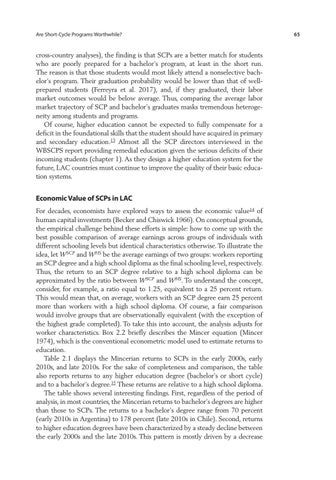Are Short-Cycle Programs Worthwhile?
cross-country analyses), the finding is that SCPs are a better match for students who are poorly prepared for a bachelor’s program, at least in the short run. The reason is that those students would most likely attend a nonselective bachelor’s program. Their graduation probability would be lower than that of wellprepared students (Ferreyra et al. 2017), and, if they graduated, their labor market outcomes would be below average. Thus, comparing the average labor market trajectory of SCP and bachelor’s graduates masks tremendous heterogeneity among students and programs. Of course, higher education cannot be expected to fully compensate for a deficit in the foundational skills that the student should have acquired in primary and secondary education.13 Almost all the SCP directors interviewed in the WBSCPS report providing remedial education given the serious deficits of their incoming students (chapter 1). As they design a higher education system for the future, LAC countries must continue to improve the quality of their basic education systems.
Economic Value of SCPs in LAC For decades, economists have explored ways to assess the economic value14 of human capital investments (Becker and Chiswick 1966). On conceptual grounds, the empirical challenge behind these efforts is simple: how to come up with the best possible comparison of average earnings across groups of individuals with different schooling levels but identical characteristics otherwise. To illustrate the idea, let WSCP and WHS be the average earnings of two groups: workers reporting an SCP degree and a high school diploma as the final schooling level, r espectively. Thus, the return to an SCP degree relative to a high school diploma can be approximated by the ratio between WSCP and WHS. To understand the concept, consider, for example, a ratio equal to 1.25, equivalent to a 25 percent return. This would mean that, on average, workers with an SCP degree earn 25 percent more than workers with a high school diploma. Of course, a fair comparison would involve groups that are observationally equivalent (with the exception of the highest grade completed). To take this into account, the analysis adjusts for worker characteristics. Box 2.2 briefly describes the Mincer equation (Mincer 1974), which is the conventional econometric model used to estimate returns to education. Table 2.1 displays the Mincerian returns to SCPs in the early 2000s, early 2010s, and late 2010s. For the sake of completeness and comparison, the table also reports returns to any higher education degree (bachelor’s or short cycle) and to a bachelor’s degree.15 These returns are relative to a high school diploma. The table shows several interesting findings. First, regardless of the period of analysis, in most countries, the Mincerian returns to bachelor’s degrees are higher than those to SCPs. The returns to a bachelor’s degree range from 70 percent (early 2010s in Argentina) to 178 percent (late 2010s in Chile). Second, returns to higher education degrees have been characterized by a steady decline between the early 2000s and the late 2010s. This pattern is mostly driven by a decrease
65

